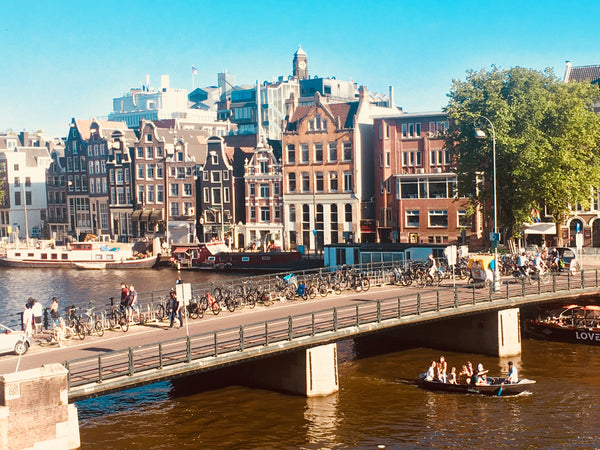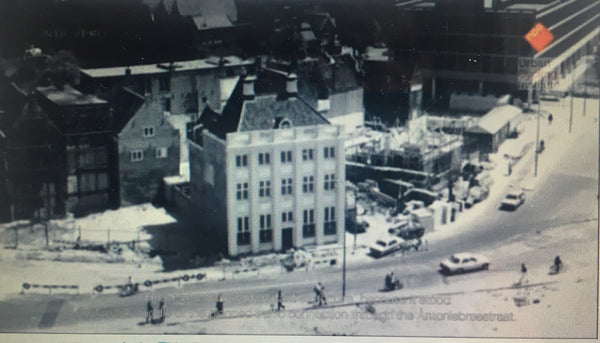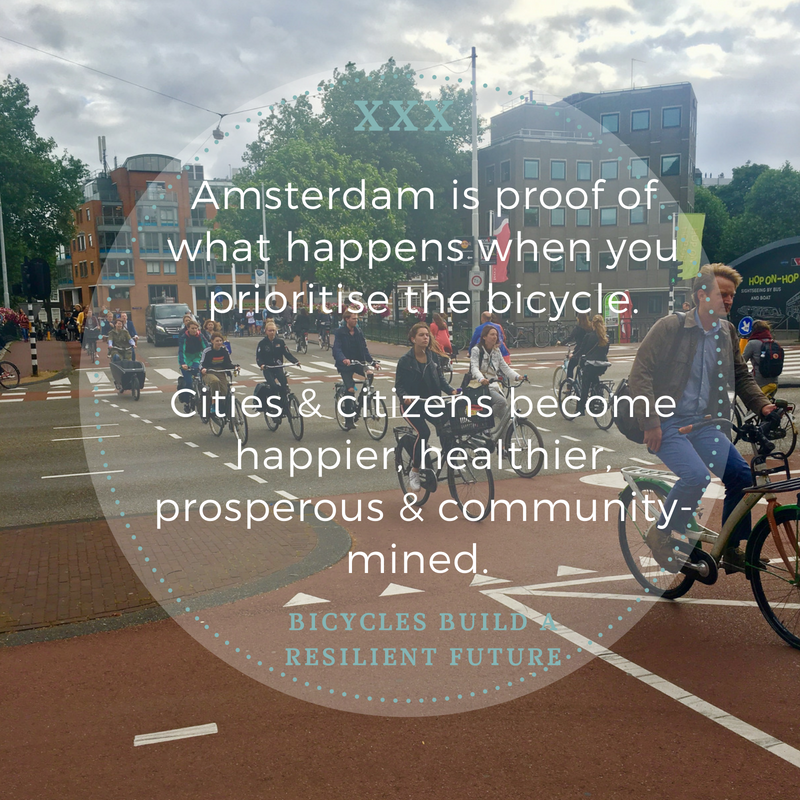You may think the Dutch cycle because of the 29,000km of connected cycle paths or 7,000km of designated bicycle lanes or because of the flat terrain. Maybe it’s because there are 1.3 bicycles for every citizen (man, woman, & child) in the Netherlands and on average each person cycles 878 km per year. Or is it because, as a country, 4.5 billion trips are made by bicycle each year? Could it just be that the Dutch are unconsciously skilled at riding a bike? Sure, take all of this into consideration, but we’re just barely scratching the surface.

The real and most important reason for the Dutch national habitus is that there has always been a bicycle culture. The bicycle has been a main means of transportation for the Dutch since the 1940’s. The Dutch don’t show off their wealth, social ostentation has been ostracized. Cycling is and was for everyone; rich, poor, and yes, even the Dutch royalty ride bicycles. Riding your bicycle shows that you are ‘normal’. Cycling in the Netherlands is a way of showing off by not showing off, despite all your wealth. In the Netherlands, you never quite know whom you may be cycling side by side with, as the Netherlands is an egalitarian society and one to aspire.
Cycling becomes a part of yourself and you just don't think about it.
Consider how the Dutch kept their cycling history alive when other countries couldn’t. It would take a series of important events, when put into motion; would create the Amsterdam we know today.
The perfect storm:
To understand why the Dutch cycle we first must understand their past to understand the present.
In the 1960’s and 1970’s, urbanization slowly started to take over. Road networks and highways were being built across the country. With the increase of the motorized traffic, cycling was under severe threat of being expelled from Dutch cities. Only thanks to fierce activism and a number of decisive events would Amsterdam succeed in becoming the bicycle capital of the world.
Accident of History:
Amsterdam was heavily dilapidated during World War II occupation. The Netherlands was changing, the Dutch cycling culture was at risk and urbanization of highways and car parks slowly started to take over the streets that were once occupied by the people who live there.
The Dutch started following the American example of ‘city forming’. This meant space for cars, offices, services and for the university within the city core. City planners approved expressways through the city centres to allow for more traffic and the residential neighbourhoods were to be pushed outside of the city centres.
In Amsterdam, demolition crews began clearing large spots in historic neighbourhoods. The Nieuwmarkt was the target for the new metro line and a super-highway. This historical neighbourhood was heavily dilapidated during WWII. With a lack of maintenance of the buildings those that could, moved out, and this left only the poor and elderly to remain.
The Nieuwmarkt was a forgotten neighbourhood, filled with abandoned buildings, ripe for demolition; at least this was the view of the municipality of Amsterdam. Eleven historical buildings were demolished, canals were filled in to accommodate the urbanization machine and to build an inner city highway. These plans were met with a fierce resistance. Inhabitants of these buildings refused to leave voluntarily and this lead to heavy rioting. It was a battle for the Nieuwmarkt neighbourhood, it was a fight for a livable city.
Watch the video below and be prepared to be moved.
AndereTijden4 converted from marco te brommelstroet on Vimeo.
At the same time, there was a heritage-movement emerging against the demolition of monuments in the Nieuwmarkt and in Amsterdam, as a whole. Huis Pinto was so important to acquire because it stood right in the middle of the planned traffic connection through the Antoniesbreestraat (St. Anthony's Broad Street). This was the turning point. Preserving and restoring Huis Pinto would make building the road through the Nieuwmarkt impossible; this battle was won. In 1972 the historical neighbourhood of the Nieuwmarkt was no longer in consideration for a new inner city superhighway.

Still of Huis Pinto, Amsterdam AndereTijden4 converted from marco te brommelstroet on Vimeo.
The heavy rioting still lingered in the Nieuwmarkt against the construction of the new metro line. It was a painful battle that ended in 1975 at the hands of 800 police officers.

Still of 800 police imposing themselves on the protesters in the Nieuwmarkt AndereTijden4 converted from marco te brommelstroet on Vimeo.
Against the wishes of the resistance the new metro line was built (it’s there today) and the Nieuwmarkt neighbourhood was also rebuilt. The historical neighbourhood of the Nieuwmarkt is now one of the most expensive neighbourhoods in Amsterdam.
Social Change
In the 1960’s and 1970’s, with the growing number of cars and their huge traffic flows, they slowly but surely began to take over the streets.
1970's: The children needed their bicycles to ride to school. Parents wanted safe infrastructure for their children.
In 1971 traffic deaths had grown to a staggering 3,300 deaths and most troubling was the 400 children also killed in traffic accidents that year. This tragic loss led to protests and the most famous “stop de kindermoord” (stop the child murder) demonstrations. Its members held bicycle demonstrations and organized open streets where children were allowed to play safely.
Eventually, stop de kindermoord became subsidized by the Dutch government. The intolerable amount of deaths was a real concern for Dutch politicians who were becoming aware of the many advantages of cycling.
Oil Crisis
The 1973 oil crisis was another event that affected the way the Dutch interacted with the cars they were driving. It quadrupled the price of oil and the Dutch prime minister Den Uyl made a plea to its citizens to adapt to a new lifestyle, to get serious about saving energy. The Dutch government then proclaimed a series of car-free Sundays (now being adopted across the globe). During these car-free days, the streets began to fill with children playing on the deserted motorways and people were suddenly reminded of what life was like before urbanization of the car.

Without knowing it, the people who participated in these counter-movements, along with their fierce resistance to protect the historical qualities of the city, stopped the urbanization of highways and contributed to the Amsterdam we know today; a happy, liveable city. Politicians finally realized the importance the bicycle had on society. Land use policies were created that banned big box retail and the creation of large car parks from the Netherlands. This had an effect on the rest of the country and small-scale retail and grocery stores started to pop up in every neighbourhood making the most basic household items to be found by foot or by bicycle, but most importantly, this movement resulted in guest status for the cars and changed the face of a Nation.
If you ever want to understand why the Dutch cycle and how Amsterdam became Amsterdam as you know it today, and to which many cities aspire, understanding these moments are key.


 Nothing will be posted on your behalf.
Nothing will be posted on your behalf.


Great article! This is something that should be taught at elementary schools in order to preserve this beautiful cycling culture that we can and should be proud of. I do believe that cycling is in our blood because if it wasn’t, these events as mentioned in the article, would never have occurred in my opinion. Cycling offers tremendous value to the life’s of the Dutch and if other people around the world would give it a good chance, it would do exactly the same. That value can be described as true freedom. A city in which there are more bicycles than cars, it also changes the way people interact with each other, more meaningful and personal if you like.
I agree with most of your assessments here. I grew up in the 60’s and 70’s just outside of Amsterdam. The Nieuwmarkt riots and squatters were the big news. I wasn’t aware of the plans of building a highway through the inner city, but probably because I wasn’t paying too much attention to municipal politics at the time.
I do know that after the WWII and in the 60’s and 70’s there wasn’t a lot of wealth to go around. I remember when we bought a new car. It was quite something. Most people in our neighbourhood walked and cycled to work and school. Cycling is in the Dutch blood. I always tell people here, I was born on a bike and if I wanted to go anywhere, I had to ride my bike to get there because my dad was working and mom didn’t have a driver’s license.
Europe is also a community oriented continent with a grocery store every 3 or 4 blocks. Everything you need is within a 5KM bike ride, unlike North America.
Leave a comment